Finca Luna Nueva Guest Blog
By Daniela Ibarra-Howell, CEO and Cofounder, Savory Institute
January 2019
Savory Global Team Finds Inspiration, Community, and Being in the Moment at Finca Luna Nueva
Finca Luna Nueva is pleased to feature this guest blog written by Daniela Ibarra-Howell, CEO and Cofounder of the Savory Institute, a global organization dedicated to advancing regenerative organic agriculture and holistic livestock and grassland management. The Savory team recently visited Finca Luna Nueva for a planning retreat and to further its work in tropical Central America. Visit www.savory.global.
The Savory Institute and its global network are dedicated to regenerating the grasslands of the world. Our team is deeply committed to creating conditions of abundance as we go about tackling land-based solutions to global desertification and climate change. Abundance and diversity build resilience and are outcomes of the underlying health of a system. The nurturing of ecosystem health is a core of driver of our organization.
When it comes to nurturing ecosystem health, asking what Nature intended is a good starting point. In order to manage land in Nature’s image, we have to know or at least have a good guess at what Nature intended for that piece of land. A keen observer of the land, Allan Savory’s key insights have helped farmers around the world heal their land.
One of Allan’s key insights is the concept of brittleness. Brittleness, in this case, does not mean fragility but refers to the distribution of humidity throughout the year. It is very important to understand where a piece of land lies on the brittleness scale, as the same tools will have to be applied differently and will have different outcomes. To figure out where you are on the brittleness scale, you may look at how plant material is breaking down – is it rotting and biologically decaying, or is it oxidizing, standing, and turning brown and then gray? Are perennial grass plants growing tightly together, or are there large areas of bare ground and capped soil?
Brittle environments are seasonally humid, which means that during the dry season biological activity ceases. The crucial role of the herbivore in these environments is to bring in moisture and microbes (in the rumen) to biologically recycle the biomass that grew in the humid season, feed the soil, and prepare the plant to receive sunlight again when rains start. This is what happened for eons as grasslands evolved. In non-brittle environments, where humidity is high and the decay of plants happens year-round, the role of the herbivore is less critical to ecosystem health – bugs and microbes are active and at work out in the open environment, all the time.
Regenerating a Changing Landscape
However, in many non-brittle environments, the landscape has been changed by human activity and a new state needs to be managed accordingly. This is the case in the heart of beautiful Costa Rica, where in places, the rainforest has been opened up by human activity, and pastures for grazing have been planted. While grazing, in general, can be hard on any land that is typically forested, holistic planned grazing, involving the movement of livestock in a way that mimics natural grazing patterns of wild herds, can increase soil carbon and improve biodiversity, and result in nutrient-rich food, a complex and resilient environment, and healthy soil. When done wrong, all of these indicators of ecosystem health suffer.
As farmers, our primary input is sunshine, and our utmost responsibility is to harvest it via photosynthesis of plants. For farmers in the tropics working with pastures, natural or planted, herbivores properly managed are key to maximizing the ability of plants to photosynthesize, sequester carbon in soils, and mitigate climate change. Holistic planned grazing helps farmers do this while accounting for the myriad considerations and complexity they need to manage for.
Tom Newmark, Cofounder of Finca Luna Nueva Lodge (FLN), is a “larger than life” advocate for putting carbon underground via photosynthesis of healthy plant communities. Of course, humans and animals are key design and implementation components of his work. Tom is passionate about and devoted to fostering biodiversity through the noble process of producing nutrient-rich, healthy food regeneratively while building fertile soils. This approach is key to addressing climate change. Tom’s laboratory is the amazingly beautiful Finca Luna Nueva, an oasis of abundance and peace in the heart of Costa Rica. His commitment to stewardship of the land, animals, and people is seriously and meticulously executed by FLN lodge Cofounder and Farm Founder and Master Steven Farrell.
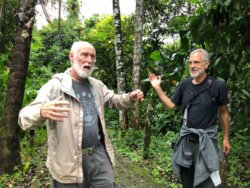
Steven Farrell (l) and Tom Newmark
Tom was excited and giddily welcoming when I reached out to discuss the idea of coming with Allan Savory and the team to Finca Luna Nueva for a week of uninterrupted work. After all, what better place for our team to meet than this secluded exemplar of regenerative agriculture? The idea became a reality in October as we gathered at FLN to design Savory’s 2019 strategy.
Inspiration, Community, Pace– Pillars of our Unforgettable Time at Finca Luna Nueva
“Inspiration” came from the incredible beauty and elegance of the natural and built spaces, the birds waking us up in the morning with their songs, the fragrance of the tropical fruits we got to taste at the base of the trees that bore them, and the flowers sprinkled around the forest, on our bedding, and our hairdos.

Yellow-throated Toucan eating fruits at Luna Nueva
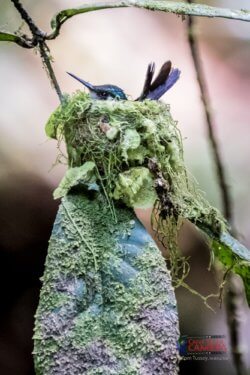
Nesting hummingbird along Rio Chachagua. Photo by Tom Tussey
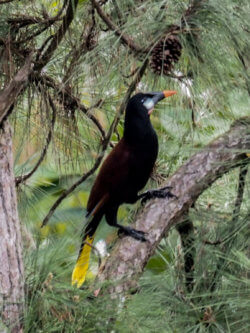
Montezuma Oropendolas were there by the hundreds or thousands
while we were at the farm!
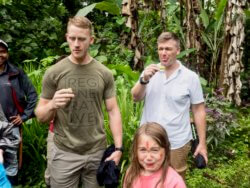
Not all the fruits were sweet. Note the pucker following tastes of “mimbro” a/k/a “bilimbi,” a relative of starfruit that doesn’t bother with being sweet! They look and taste like sour pickles growing directly from the tree limbs
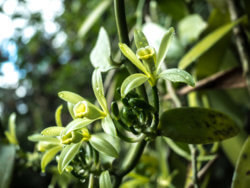
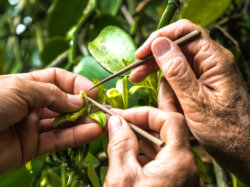
Vanilla orchid vines grow all around the farm, interspersed with other plants in accordance with regenerative principles. Here’s a blossom awaiting hand pollination.
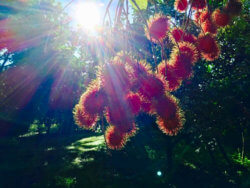
Rambutans were dripping by the thousands off the hundreds of trees growing around the farm. These taste like the sweetest lychees you’ve ever tasted.
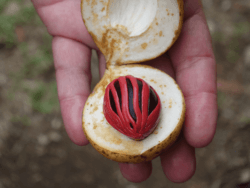
Two spices in one! “Nutmeg” is the dark seed surrounded by a red helmet that, when dried and ground, we call “mace.”
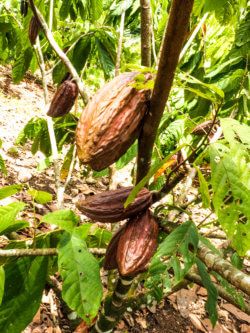
And then there was cacao all over the farm! We experienced the sweet fresh pulp right off the tree, and then we made the ancient Mayan Drink of the Gods and what we now call chocolate from the fermented and roasted seeds.
Inspiration came as we were wrapped in the magic of the rainforest and were reminded, deep inside our DNA, of how we are really one with all.
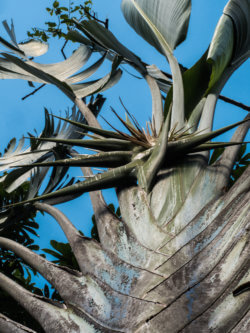
A Travelers Palm in bloom during our visit. According to Tom and Steven, it had never before bloomed, and we were thrilled that the giant blossom greeted us!
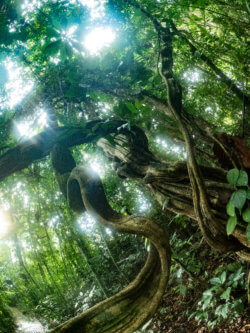
Along the Rainforest Mysteries Trail, an easy hike near the lodge and restaurant. You’re looking at a Monkey Ladder vine climbing up into the canopy
And of course, for this bunch of livestock lovers, inspiration came from the livestock that grazed happily, and properly, in the pastures at Finca Luna Nueva.
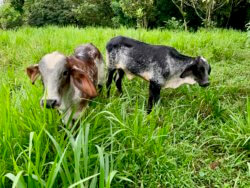
Two youngsters in the pasture. The breed is “girolando,” representing a mix of 5/8 Holstein and 3/8 Gir
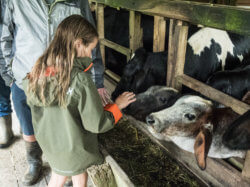
Visiting the livestock in the milking station, where they enjoy sweet silage from the “protein bank” of plants growing near the dairy
Savory senior program director Byron Shelton, Savory Hub leader from California’s Jefferson Center for Holistic Management Spencer Smith, and Steven Farrell himself conducted measurements of ecosystem health following Savory’s Ecological Outcome Verification (EOV)protocol, and were all inspired by the shared learning – and spooked by the appearance of a curious snake.
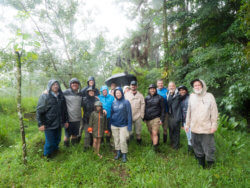
The team hiking on a rainy morning inspecting the holistically managed pasture
“Community,” such vital feed for our souls, came from our hosts, Tom and Terry, Steven, and the amazing FLN staff who cared for us like family; who generously poured on us lessons of soils and plants, animals big and small, of chocolate and dreams, climate and activism, markets and investment, handmade jewelry and good rum… and who, in sharing their journey and vision for the future, enriched our own.
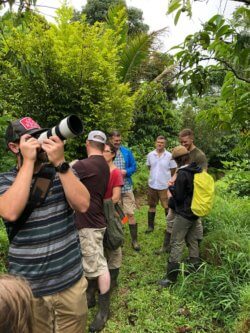
Out in the food forest studying agroecology
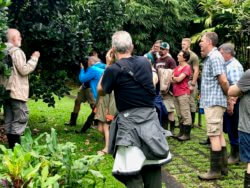
Good cameras and good binoculars – the gear you want to have!
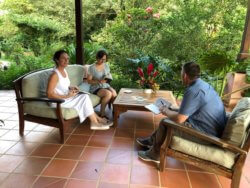
Gathering at Casa Luna to plan the year to come
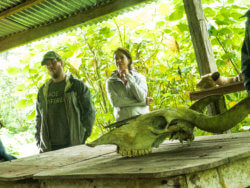
Chris and I, along with the team, learning about biodynamic preparations and
stingless Mariola bees making medicinal honey
It was felt in our teamwork, being safe to inquire, to challenge, to give up, to take on more, and to embrace change. It was felt in the harmony of the landscapes surrounding us that brought harmony to our days. It grew stronger every day, as we shared and shaped each other’s worldviews. Towards the end of our stay, other leaders of the Costa Rica regenerative agriculture movement, heads of Rancho Margotand Cirenas, joined and added to the sense of community and learning.
“Pace,” that elusive intentional attention to the moment, a gift so fleeting when our minds are trained to wander in these fast-paced times. Our pace teachers at Finca Luna Nueva were the sloths – mama and baby – taking their time to move from branch to branch, as we watched them in awe… slowing down, being present.
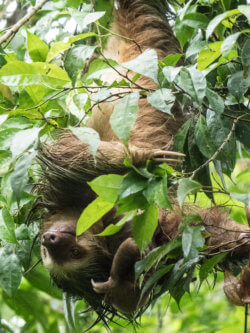
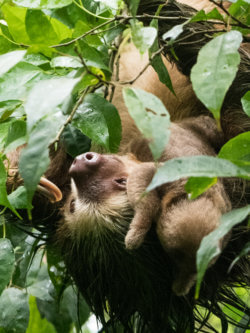
Mama and baby two-toed sloths in the forest near the lodge. The baby loved positioning itself on the mama’s head and face – amazing how she navigated upside down!
It manifested in full immersion, creativity and flow during the day, and in evenings filled with laughter and play, releasing tensions and cherishing the blessing of being together.
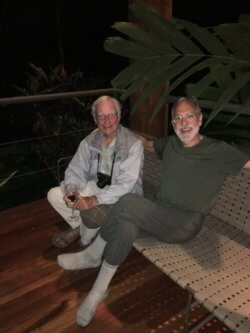
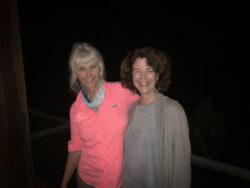
Allan and Jody relaxing with Tom and Terry after a busy day around the farm
Tired, grateful, and fulfilled, with our 2019 plan almost complete, we left Finca Luna Nueva changed for the better. A regenerating landscape, a thriving and world-changing community, and the sweet taste of meaningful work… that is pura vida! Gracias Finca Luna Nueva!
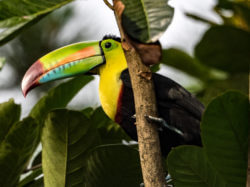
Hurry back, says a resident Keel-billed toucan!

